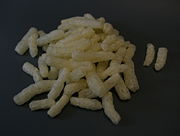- Loose fill
-
Transportverpackungen bzw. Versandverpackungen sind Verpackungen, die den Transport von Waren erleichtern, die Waren auf dem Transport vor Schäden bewahren oder die aus Gründen der Sicherheit des Transports verwendet werden.[1]
Inhaltsverzeichnis
Aufgaben
Transportverpackung sollen die Ware schützen und dabei möglichst geringe Kosten verursachen. Wichtige Aspekte sind das Handling der Verpackung sowie der verpackten Ware und die Entsorgung, außerdem die Eignung für Retouren und die Schonung von Ressourcen (kein Missverhältnis von Verpackung zur Ware). Bei gefährlichen Gütern (Gefahrgut, Gefahrstoffe) muss zudem der Schutz der Umgeben vor dem Inhalt sichergestellt werden.
Arten
Zu den Versandverpackungen zählen Behälter wie Fässer, Kanister, Kisten, Säcke, sowie Paletten, Kartonagen, geschäumte Schalen, Schrumpffolien und ähnliche Gebinde zu Transportverpackungen.[2]
Beispiele für Transportverpackungen sind:
- Papp-Paletten und Folien als Verpackung für Getränkedosen
- Kisten für Investitionsgüter, wie z. B. Maschinen, Motoren etc.
- Schachteln und Folien, die als Verpackungsmaterial für Möbel dienen
- Packstücke, in denen eine größere Stückzahl einer Ware zu Sammelgut zusammengefasst wird, wie z. B. Zahnpastatuben, Konserven.
- Füllmaterial wie Verpackungschips zum Schutz der Ware vor Beschädigungen
Rücknahmepflicht
Laut deutscher Verpackungsverordnung sind die Hersteller seit Dezember 1991 zur Rücknahme der Verpackungen verpflichtet, die wiederverwendet oder der stofflichen Wiederverwertung zugeführt werden müssen. Transportverpackungen aus Nachwachsenden Rohstoffen dürfen auch energetisch verwertet werden. Bis Ende 2012 sind Kunststoffverpackungen aus kompostierbaren biologisch abbaubaren Werkstoffen von der Rücknahmepflicht befreit.[3]
Normen und Standards
In Deutschland ist die Verpackungsverordnung zu beachten, in Österreich gilt die Versandbehälterverordnung von 2002 (BGBl. II Nr. 202/2002). Für die Verpackung von Gefahrgut sind zudem die Normen des internationalen Gefahrgutrechts[4] wie auch des Gefahrstoffrechts einzuhalten.
Weblinks
- Transport-Informations-Service Fachinformationen rund um das Thema Verpackung
Einzelnachweise
- ↑ Verpackungsverordnung, §3, 1.4
- ↑ etwa: § 3 Abs. 1 Satz 1 deutsche Verpackungsverordnung
- ↑ Verpackungsverordnung, §§ 6, 7 und 16
- ↑ Merkblatt Gefahrgut-Transporte. landi.ch. Abgerufen am 14. Juni 2008. (pdf, de)
Wikimedia Foundation.

